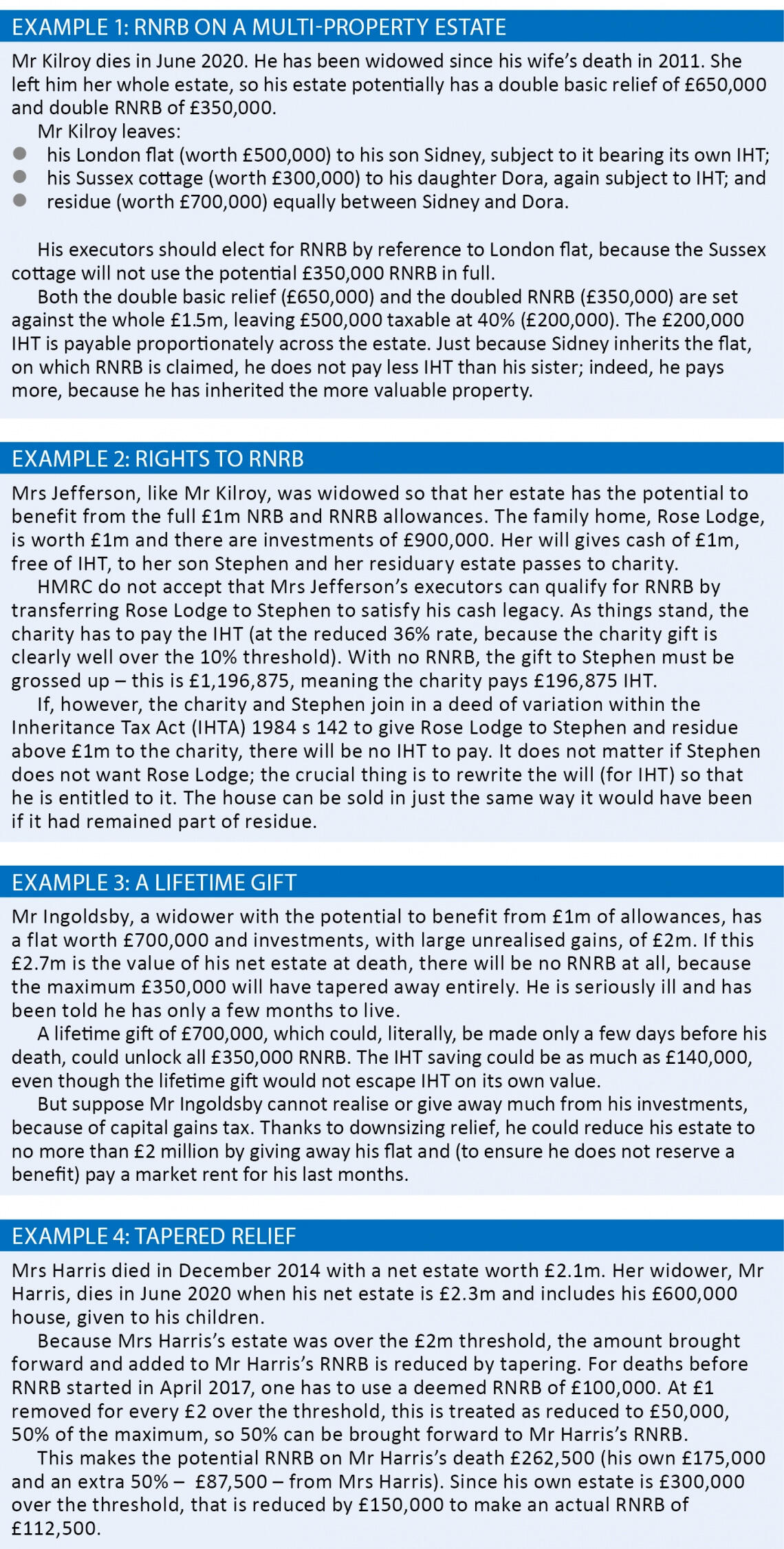Home thoughts

Anthony Nixon explores complexities of the residence nil rate band and how you can maximise the relief
Key Points
What is the issue?
From 6 April 2020, some individuals will have £1m worth of inheritance tax allowances.
What does it mean to me?
Do you know which of your clients will not qualify for the full reliefs? Or what action can be taken to maximise relief?
What can I take away?
More knowledge, and some planning ideas, on this extraordinarily complex part of the inheritance tax legislation.
Attitudes to inheritance tax (IHT) vary hugely. The strong emotions it inspires must, at least partly, be linked to deaths of parents and the value of homes. George Osborne’s 2015 announcement of a new ‘£1m IHT-free allowance’ specifically addressed this with the creation of the residence nil rate band (RNRB).
Unfortunately, the narrow targeting of RNRB on parents passing on the family home makes it an extraordinarily complex relief at a time when we are also told that tax is supposed to be fair and simple.
RNRB is excellent for those who can take advantage of it, but full of traps for the unwary. It is all too easy to miss the opportunity to take full advantage, which sometimes needs to be done before death, but can sometimes be remedied in the two years following. This article sets out some ways of maximising relief.
The relief
The relief started on 6 April 2017 as an extra allowance of £100,000 when, on death, an interest in a home is inherited by descendants.
RNRB has increased by £25,000 in each of the following tax years. From 2020/21, RNRB is £175,000 and, as has been the case from the start, can be increased or doubled for the survivor of a married couple.
RNRB is additional to the standard £325,000 nil rate band, which can also be doubled when a widow or widower dies. This amounts to the potential for allowances of twice £325,000 and twice £175,000, which can take £1m out of IHT.
Just as with the standard £325,000, an extra RNRB is brought forward to the estate of a widow or widower to the extent that their late spouse did not use the allowance. Because RNRB did not exist until 6 April 2017, it cannot have been used by a spouse who died before then. So most widows and widowers dying now have double RNRB. All I say in this article about married couples applies in the same way to those registered as civil partners.
Conditions for relief: qualifying residential interest
Unless the downsizing conditions can be satisfied (see below), the deceased must have died owning a qualifying residential interest (QRI). This is an interest in residential property that has, at some point during the deceased’s ownership, been their residence.
There is no minimum period of ownership, and so long as they still own an interest at death, the deceased need not have lived in the property at death or, indeed, for many years past.
The test of what is a residence is similar to that for capital gains tax main residence relief. But the residence on which RNRB is claimed does not have to have been the deceased’s main residence.
However, only one residence can qualify for RNRB. If an individual owned interests in more than one home, their personal representatives must choose which to base RNRB on. Because RNRB is a relief against the whole estate, not just against the value of the home that qualifies for relief, the personal representatives should always choose the most valuable property.
Conditions for relief: closely inherited
RNRB is only available if a QRI is ‘closely inherited’, which means that it must pass on death into the IHT ownership of a ‘lineal descendant’. This includes not only children and grandchildren and so on but is extended to include:
- spouses and civil partners of children and grandchildren, etc.;
- widows, widowers and surviving civil partners of children or grandchildren, etc. (as long as they have not remarried); and
- adopted children, fostered children and stepchildren (and children and grandchildren etc., and widows etc. of any of these individuals).
- However, there is no RNRB for:
- a life partner to whom the deceased was not married;
- any children, etc. of an unmarried partner; and
- any other class of relatives, even if they shared the deceased’s home.
RNRB and trusts
Trusts, whether before or after death, add another level of complexity. The rule of thumb is as follows:
- If the QRI was in trust before death (it will have been in a qualifying interest in possession if it is liable to IHT on death), it must pass to descendants outright.
- If the QRI is given to a trust on death, RNRB will usually only be available if that trust is an immediate post-death interest; in other words, an interest in possession.
Bear in mind that a trust that takes effect on death can usually be varied to create an interest in possession. Under IHTA 1984 s 144, the interest is treated for IHT as if it arose on death, so can satisfy the RNRB conditions.
If there was an interest in possession in place during the deceased’s lifetime, on the other hand, it is too late to make changes after death. RNRB will usually only be saved if the interests arising on death have been made absolute while the deceased was still alive.
£2m limit and tapered relief
RNRB is reduced when the net estate is worth more than £2m. For every £2 above £2m, £1 relief is withdrawn. The net estate for the £2m limit includes the value of assets in a trust in which the deceased had an interest in possession, any jointly owned assets, and any gifts in which the deceased had reserved a benefit. There is no reduction for any reliefs or exemptions, such as on gifts of business or agricultural property or to spouse or charity. On the other hand, the net estate does not include lifetime gifts, even those made only just before death.
As well as reducing the deceased’s own RNRB, tapering may also reduce the RNRB that can be brought forward from a deceased spouse, if that spouse had an estate of more than £2m.
£2m is the real limit for RNRB
While it might seem that RNRB gives some benefit to those who die with assets worth more than £2m, the effect of tapering is a 60% rate of tax above the threshold. I prefer to plan for clients to own no more than £2m when they die.
Downsizing provisions
While the general rule is that the RNRB is given only to estates including a QRI, individuals who have downsized or disposed of their home before death will, if conditions are met, still obtain RNRB with a ‘downsizing addition’. It does not matter whether the disposal was a sale or a gift or whether it was of the whole or part of the property.
The details of the downsizing rules are horrendously complex, and there are so many possible scenarios that it is not possible to cover all of them here.
The method of calculating the downsizing addition attempts to mirror both the transferable nil rate band and the main RNRB rules by looking at the amount of RNRB lost at the time the former property interest is disposed of. A rather arbitrary formula is used to arrive at a percentage that is then applied to the RNRB potentially available at the deceased’s death, providing assets of equivalent value are left to ‘lineal descendants’. Sometimes, this provides the equivalent of a full £175,000 or £350,000 RNRB. But it will, for example, be worthless in the case of a widow whose home was always in her husband’s sole ownership.
Tips for maximising RNRB: planning while both of a married couple are still alive
Try to ensure neither spouse dies with assets worth more than £2m. Arrange transfers between them to equalise what they own. A nil rate band discretionary trust in the will of the first spouse to die can take £325,000 out of the survivor’s death estate, and so preserve RNRB. This is the best planning for any assets with business or agricultural relief owned by the first to die, even apart from the fact that those assets might take the survivor over the £2m threshold.
Sometimes it makes sense to use the RNRB of the first to die, rather than letting it be carried forward to the survivor. This will be the case if the survivor will definitely have more than £2m at death. Or it may make the difference between the survivor’s estate being above or below the critical threshold.
A nil rate band discretionary trust is almost always worthwhile if either spouse has previously been widowed. This can give the couple £1.5m of allowances between them. If both spouses were widowed before marrying the other, £2m of allowances might be unlocked.
Tips for maximising RNRB: after the death of the first to die of a married couple
In the two years after the first death, redirect assets to take advantage of IHTA 1984 s 142 and/or s 144. This can correct or refine what has or has not been included in the will. At this time, it will usually be much easier to assess the likely value of the survivor’s estate and plan accordingly.
To use the first spouse’s RNRB over part of a home where the survivor is still living, consider giving children, etc. an immediate post-death interest (IPDI) in a fraction of the home.
Tips for maximising RNRB: unmarried couples or family or friends sharing
Remember that unmarried couples cannot:
- transfer RNRB between their estates; or
- obtain any RNRB on gifts to each other’s children.
If the first to die has children of their own (or even stepchildren from a previous marriage), consider giving those children an IPDI in part of a property where the survivor continues to live.



